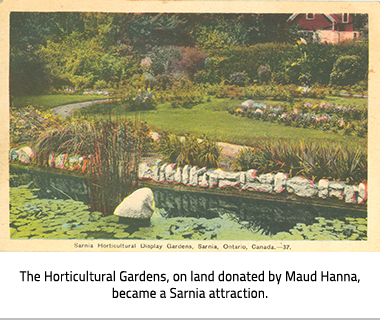The Legacy of Maud Hanna: Environmentalist, Philanthropist, and City Builder
 Celebrated philanthropist and city builder Maud Hanna grew up in Sarnia. Her father, Robert MacAdams, was owner and editor of the Sarnia Canadian newspaper. She married long-time politician and Imperial Oil president William John Hanna in 1896. Unfortunately, W.J. Hanna died on March 20, 1919. Already in poor health, he was devastated by the accidental death of his son, Lieutenant William Neil Hanna, nine days after the end of the First World War. W.J. Hanna left a two million dollar estate to Maud and their two daughters. Possessed of wealth and conviction, Maud got to work.
Celebrated philanthropist and city builder Maud Hanna grew up in Sarnia. Her father, Robert MacAdams, was owner and editor of the Sarnia Canadian newspaper. She married long-time politician and Imperial Oil president William John Hanna in 1896. Unfortunately, W.J. Hanna died on March 20, 1919. Already in poor health, he was devastated by the accidental death of his son, Lieutenant William Neil Hanna, nine days after the end of the First World War. W.J. Hanna left a two million dollar estate to Maud and their two daughters. Possessed of wealth and conviction, Maud got to work.
Both modest and reserved, Maud Hanna avoided publicity. This did not stop her from vigorously opposing or favouring city policies. She was passionate about the environment and strongly against the destruction of stately old trees. In a 1935 speech she regretted that “most of the beautiful trees of the city had been cut wastefully within the last few years” and made an “urgent plea for a tree-planting campaign.” She wrote a respected booklet about wildflowers and founded the Sarnia Horticultural Society in 1920. Hanna provided the land for the Horticultural Gardens on College Avenue and helped establish rock gardens near the ferry dock.
Hanna was also passionate about providing opportunities for children. She donated land on Mitton Street to “be used as a public recreation ground to which all persons would have access at all times, free of charge.” This is now Hanna Park. Once a week for several summers, she provided free, supervised, rides for children along the Sarnia Street Railway to Lake Huron Beach Park.
Hanna’s commitment to the area’s natural attractions led to her most significant donation. In 1932, the City of Sarnia wanted to purchase waterfront property for a park. Hanna offered to match the City dollar for dollar. When 53 acres of sand and oak woods became available, Mayor James C. Barr convinced a cash-strapped, depression-era, council to accept her offer. The property that is now beloved as Canatara Park was purchased for $20,000, with $10,000 provided by Maud Hanna.
Hanna was surrounded by trail-blazing women. Her sister, Roberta MacAdams, enlisted in the Canadian Army Medical Corps during the First World War and served as a military hospital dietician. In 1917 a special constituency was created for soldiers and nurses serving overseas. MacAdams was elected to one of two available seats. She was the second woman elected to a legislature in the British Empire and the first woman to pass a bill.
Independent and university-educated, Hanna’s oldest daughter, Margaret Spaulding, lived in the posh Toronto neighbourhood of Rosedale. Community-minded like her mother, she was made a Member of the Order of the British Empire in recognition of her community service during the Second World War. Spaulding became a passionate political activist and social democrat. She was critical of capitalism, supportive of civil liberties and human rights, and sympathetic to the plight of the common worker.
Margaret Spaulding shared her mother’s appreciation for lakeside recreation. She purchased a cabin from Huron County in 1930. It was floated to her cottage property on Lakeshore Road. The cabin was moved to Canatara Park in 1971 where it was enjoyed by Sarnians for almost fifty years. It was relocated to a new home at Lambton Heritage Museum in 2020.
Maud Hanna’s “practical idealism” produced lasting results. Hanna Park, the Horticultural Gardens, the beach at Canatara, and the city’s oldest trees exist because of her generosity and vision. Her quiet philanthropy contributed a valuable legacy to the City of Sarnia and benefitted numerous people and organizations. Hanna Memorial School was named in her honour.



 Subscribe to this page
Subscribe to this page